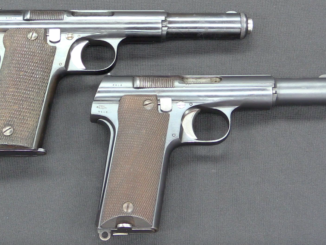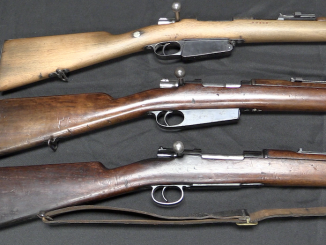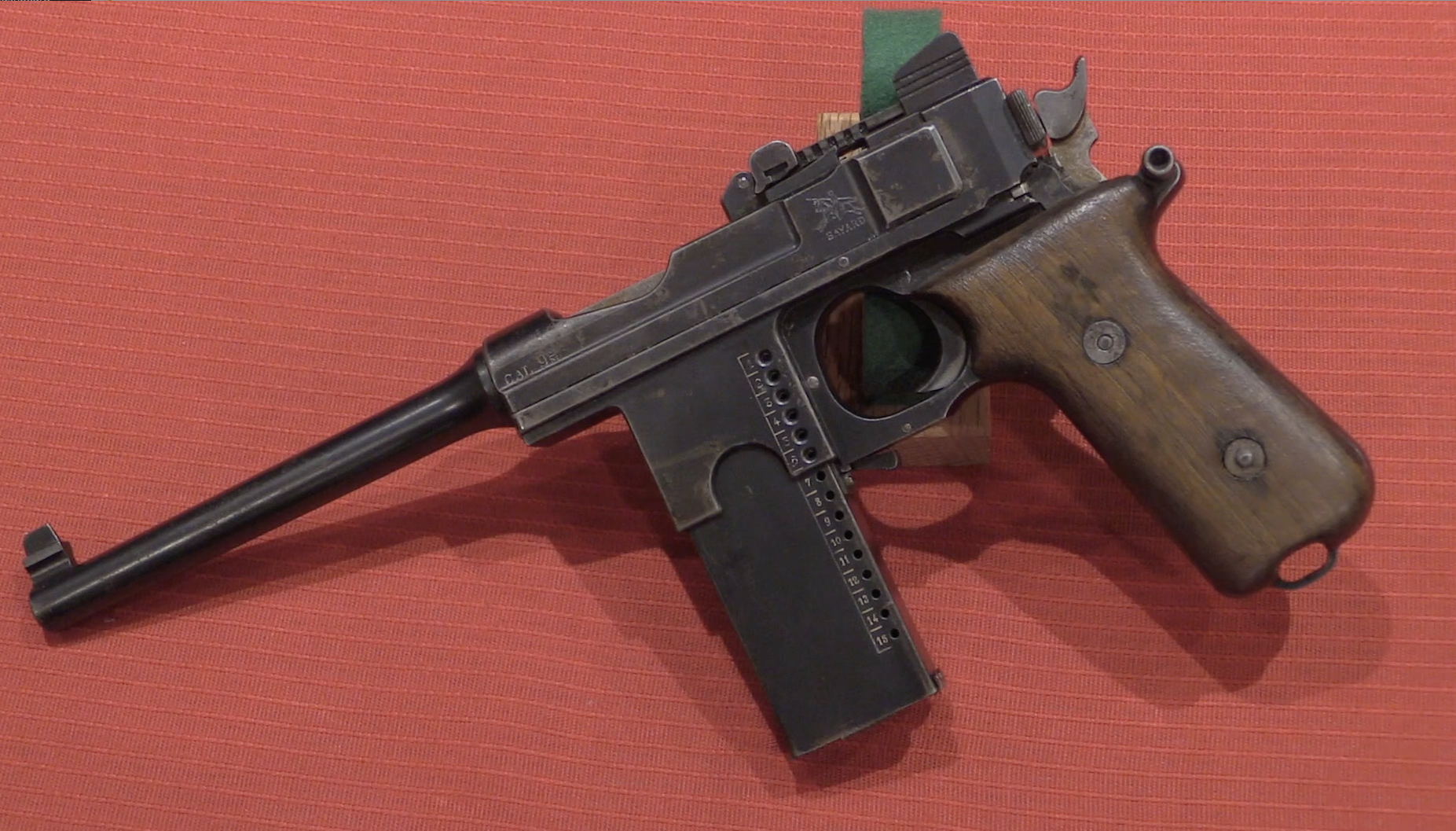I’m very happy today to present a video we did in cooperation with Oleg Volk, which I’ve titled “Last Ditch Innovation”. It is a look at two late-WW2 German prototype rifles which are the evolutionary grandparents of the CETME and the H&K series of roller-delayed firearms (91, 93, MP5, etc). Thanks to some very generous friends, we have examples of both guns to disassemble and shoot…so sit back, relax, and enjoy the show:
(edited to note: I will be fixing the sound in the video this evening, and uploading a corrected copy – sorry for the mono/stereo bug).




Excellent, excellent, excellent! Great video on some very important designs and you have done a very good job of presenting them. Combine with more Photos and a pointer to Full Circle would round this out to get a novice moving in the right direction.
Joe
EXCELLENT
Your best video.
See you at the SAR’s Building.
Pat
Well done!
Excellent!
And the Swiss Stgw 57.
This is the best explanation I have ever heard on how and why delayed blowback was developed! Outstanding Thank you
Well done. Thanks!
Don’t tell me you have somehow managed to get original 06 rifles. I am jealous as it is. the explanation of the way the bolt works is still too complicated for me, but apart from that excellent video!
It’s not entirely accurate to say that the StG-44/MP43 was “an instant hit”. In the excellent Collector’s Grade book “Sturmgewehr!”, you will find early combat reports of the MP43 which conclude that it is “entirely unsatisfactory for combat use.”
However, the video is very good. A nice, concise history of roller delayed blowback firearms.
Do not forget: the early negative reports were about the original version that fired from the open bolt. It lacked the capability for well aimed single shots.
The reports from the 1944 troop trials (unanimously IIRC) were favourable, 47 percent (based on the number of assault rifles present in the units) were very favourable or enthusiastic.
No, these are definitely reports of the closed-bolt MP.43.a. Read the book, they say it’s highly sensitive to sand and dust, and they report other problems in areas that saw no changes between early 1943 and 1945.
Mauser Gerät 06H/STG 45(M) => French AME (Atelier Mécanique de Mulhouse) 1949 / CEAM (Centre d’Etudes et d’Armement de Mulhouse) Carabine Mitrailleuse Modèle 1950 in .30M1 carbine by Ludwig Vorgrimler and Theodor Löffler => CETME Modelo B => G3 with licence production buy german governement for Rheinmetall & Heckler & Koch.
A friend ha an MKb42 as part of his collection.
Damn excellent work, Ian…Congratulations on acquiring the two examples.
A magnificently detailed and comprehensive weapons review with plenty of technical information. The effort put into this production definitely shows. Need I say more?
Thank you to all involved for sharing this with the rest of us!
Probably the best in-depth firearm video on YouTube. Excellent work!
Ian please upload the fixed version. 😛
Fluted chambers was in Russian Rifle SVT40 and AVT40
The invention of chamber fluting to ease extraction, is generally attributed to Giovanni Agnelli.
Ever conservative military bureaucrats were apparently un receptive to Agnelli’s ideas at the time, as to them, oiling cases represented a well proven technology…
http://worldwide.espacenet.com/publicationDetails/originalDocument?CC=GB&NR=191508943A&KC=A&FT=D&ND=3&date=19160619&DB=EPODOC&locale=en_EP
Chamber fluting is a neat idea, just bleed a little gas between the case and the chamber wall to partially counter the pressure within the case which is expanding it against the chamber wall,
The gas is slow to get down the flutes, so it’s unlikely to reach the level of max pressure (and I’m guessing that being against the chamber wall chills it so it is always slightly below the pressure of the gas inside the case), but it does sufficiently counter the internal pressure for the case body and neck to follow the case head out of the chamber without the case head popping off.
Agnelli first introduced the idea of fluted chambers to simplify ( non-lubricated ) primary extraction on the SIA machine-gun just before the First World War, although subsequent historical events ensured that the whole process would continue to drag on interminably through the 1920’s and into the 1930’s.
In an interesting aside, Fiat’s modification of the existing Fiat-Revelli M1914/35 machine-gun to incorporate the fluted chamber and eliminate cartridge oiling in the middle of the production run in 1938 or 1939 was a failure due to incorrect design tolerances, which resulted in the discovery that modified guns only worked properly — most ironically — when the cartridges were pre-oiled with a soaked rag. Thereafter, production M1914/35’s reverted to the old tried-and-true plain chambers and oil pumps.
Brilliant. Finally I can understand a few things about the roller-delayed system avoided by many “weapon experts” I asked. I didn´t know that the initial idea came from the bouncing bolt carrier, and interestingly the system ended avoiding it for safe fire: Now I completely understand what that damn-latch-on top left-of-the-bolt-carrier of any Cetme/G3 is for (an anti-rebound device, keeping bolt and its carrier together upon the action closes). Now, the only mistery left for me about this system is why the MP5 doesn´t have that latch…
You said gerat06h receiver was made from only 2 stampings, how were they joined, by welding along seams or ?
Second and more important, what’s your opinion on shooting both weapons, whats the feel and difference in felt recoil and handling ? Is gas system from gerat06 better than the roller from 06H, is it opposite or even is there no difference at all (which is by some logic unlikely) ?
Yes, the two sides are welded together along the seam.
The gas operated gun is a bit heavier, but has a smoother action. The difference is pretty minor, but the gas gun is a bit more enjoyable to shoot. Don’t get me wrong, the roller gun is still very tame and handles great, but there is a slight noticeable difference between the two.
Outstanding video. It’s fascinating that counteracting bolt bounce was the bug hunt that led to delayed blowback.
I really enjoyed the quality of the audio and video in this one. Keep up the good work!
many thanks for the fantastic Video
is a unique look into the Gerat 06 and 06H. and success of H&K.
I hope you make similar video about the STG 44 and show the difference between it and Ak-47.
that would be great
Interesting thing about these guns compared to AK is that albeit they are older, they use more complex stamping and in that aspect could be looked upon as more modernly made than AK, meaning that soviet stamping industry was waaaay beyond germans. Especially when looking upon the fact of the first milled receiver AKs, that were made that way because they were unable to cope with the production standards when making stamped AK receivers (too many of them ended with improper tolerances and were meant to be thrown away), and only after they refined the stampings, AKM emerged.
Speaking hypothetically “what if”, if you were to give Ak47 plans to german industry engineers during or even before the war, they would probably find it laughably simple to make.
Any chance that you’ll cover the CEAM Modèle 1950 (as mentioned by snmp above)? It’s even more “forgotten” weapon in the CETME and G3 ancestry than Gerät 06H, and there seems to be next to nothing on the Internet about it.
Any chance that you will upload the version with fixed sound?
Very interesting show indeed. The ingenuity of the german people never ceases to amaze me. Speaking of german, I am born and bred canadian who speaks, reads and writes german fluently. I am aware of the pronounciation differences between german and english, it goes both ways, so I am not trying to be sarcastic or offensive with the following. My intention is to try and help you pronounce “Gerät” which can be easy when explained by an english speaker… okay, I’ll admit, the way you say “Gerät” does hurt my ears a bit…:-)!
Here we go… “Gerät” literally means device or contraption. The word does not suggest anything to the understanding of being experimental. In your video, you say “Gerät” like an english speaking person would almost read the (imaginary) word, “Gerought”, which would have the equivalent german spelleing “Gerat” which, just like in english, has no meaning at all.
Notice that the two dots above the ‘a’ are missing. Those dots above the ‘a’ render the word into what english speaking volks can safely pronounce as “Ge-rate”. The G is unchanged and like you say it in your video presentation or how we say it in “great”. As a matter of fact, “Gerät” could also be pronounced like ge-reat!. So it goes something like this: g-e-reat!
Now, if you can roll the “R” like a german you‘d be my hero… no worries, ain’t gonna even try to teach you that.
I hope you found this interesting and worth reading.
Kind regards
George
Viewed your last ditch innovations video and it is a masterpiece of exposition and sheer, simple clarity. Congratulations! I was struck by the thought that if the Italians had used a ‘fluted’ chamber instead of oiled cartridges, their Bredas would have been a lot more effective during WW2.
After that video clip was over, I noticed that you also had one on the Vickers-Berthier LMG. Now here is a truly ‘forgotten weapon’ because it was produced in very large numbers for the Indian army during WW2. {India, like the independent countries of Canada, Oz etc. had armed forces totally independent of Britain and procured and manufactured their own weapons.) Considering that the VB served in the dry, dusty heat of North Africa and the wet, muddy heat of Burma with no complaints from the customers, it must have been a pretty good weapon. On the whole, Commonwealth infantry were well served by their Bren/Vickers LMG and so the squad was built around these weapons – rather like the Germans with the MG42.
But, of course, as a squad LMG, anything was better than the BAR so US infantry was literally saved by the Garand semi-automatic rifle.
Can that start an argument? Is there a video of a comp between a BAR, Bren, Breda, Type 96, etc on your wonderful site or elsewhere?
Cheers,
TKerr
Hello, Thomas :
Very salient point about the Vickers-Berthier — I seem to recall a number of intermittent discussions about this excellent weapon on prior FW posts, either directly or indirectly related to the then subject-at-hand. The VB was almost ( some would easily ) the equivalent of the Bren in terms of overall performance, a fitting tribute to the basic soundness of its design.
One problem I have noticed with a lot of wartime photographs is the tendency to identify a V-B as a Bren because of the external similarity, which leads me to believe that the Bren tends to get a good deal of credit that should go to the V-B.
I should have said “( some would say easily )” in Line 4 of Paragraph One — sorry about the error.
That is too cool. I had no idea that there was such a link between Mauser and the CETME.
About the origin of the Heckler & Koch G-3:
In 1950, Ludwig Vorgrimler, former Mauser Werke’s engineer, went to Spain to work in the CETME (Spanish Government defense design bureau), where, with Spanish collaborators (mainly Luis Wilhelmi Castillo) began the development of an assault rifle based on the StG 45(M), in parallel with the excellent 7.92x40mm CETME cartridge, brainchild of German ammunition expert Dr. Günther Voss.
In 1952 appeared the CETME A in cal. 7.92x40mm, and latter the A-2 model in 7.62 mm cal. (both 7.62×40 and 7.62×51 CETME/NATO), that led to the CETME B assault rifle, cal. 7.62×51 CETME/NATO (a special cartridge that used the 7.62 NATO case with a lighter and longer bullet, and less powerful, better adapted to the concept of assault rifle). The CETME B was adopted in 1957 by the Spanish Army. CETME A and B are identical in construction to the German Heckler & Koch G-3.
The history of the Heckler & Koch G-3 (Gewehr 3) began with the renaissance of German Bundeswehr in 1956. A new rifle was needed to rearm it (temporally supplied with Garands). CETME technicians are in touch with Germany who after the war was banned to produce arms and has no weapons industry. These German firms were Rheinmetall (reborn in 1957 as arms maker, dedicated until then to the manufacture of steam boilers and refrigeration systems) and Heckler & Koch (founded in 1949 by Edmund Heckler, Theodor Koch and Alex Seidel, former Mauser employees, for production of replacement parts for household appliances and bicycles). Towards 1957 Germany decided to supply the newly formed Bundeswehr with a model of rifle that must be manufactured in the country, testing the FN-FAL (Gewehr G1 o FN-Gewehr) , the SIG AM-55/Sturmgewehr 57 (Gewehr G2) and the Spanish CETME or Gewehr G3 (until this point entirely developed in Spain). Though the German Army preferred the Spanish rifle, as there in no arms industry in Germany, 100.000 FAL rifles were bought to the Belgian firm Fabrique Nationale.
Finally in 1959 Spain signed a contract to yield manufacturing rights of the CETME model B to the German Defense Ministry, and was adopted as Gewehr G3, adapted to 7.62 NATO full-power ammo and with minor German modifications. In that year the firm Heckler & Koch was granted by Bundeswehr (owner of the license) with a contract to supply the G3 infantry rifle.
As you can read in Heckler & Koch website:
“As one of only a few German firms, Heckler & Koch is already permitted to manufacture weapons and replacement parts for the police, German federal border police and the allied occupation troops during the armaments ban enforced by the Allies.
After the end of the armaments ban, as well as the decision in favor of German rearmament and the accompanying establishment of the Bundeswehr in 1955, Heckler & Koch is transformed into a purely armament business.
In 1959, Heckler & Koch is awarded a Bundeswehr supply contract for the G3 infantry rifle. It becomes the standard rifle of the Bundeswehr. Since then, Heckler & Koch has been a key element of the security infrastructure of Germany and the West”.
And in Rheinmetall website: “Its Rhineland-based subsidiary, Rheinmetall AG, is transformed into Rheinmetall GmbH in 1957. In parallel with the creation of the Bundeswehr, Rheinmetall reverts to the production of military equipment, manufacturing machineguns, automatic cannon and ammunition for the country’s new armed forces”.
So the G3 rifle was a licensed version of Spanish CETME, developed in Spain in the fifties by German technicians with Spanish assistance, facilities and money.